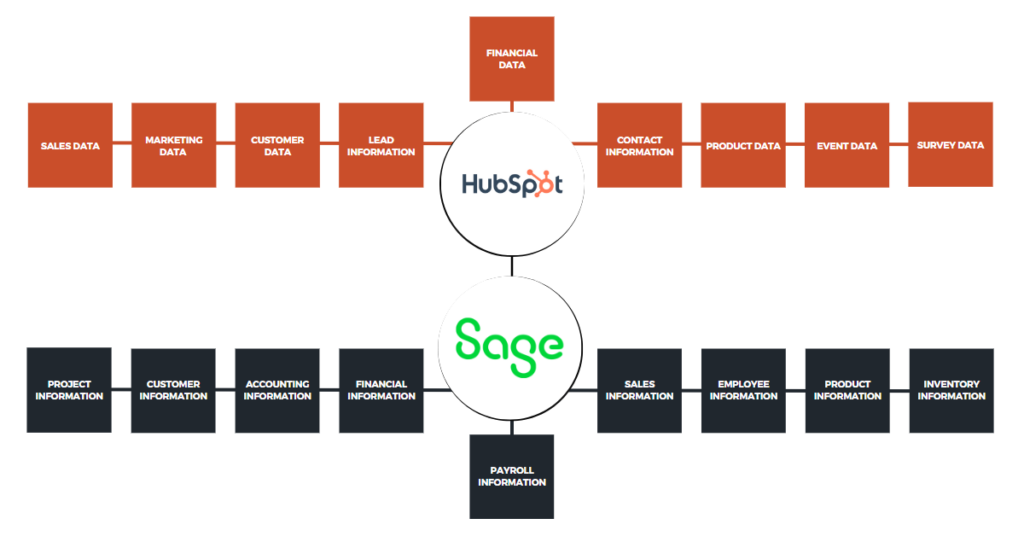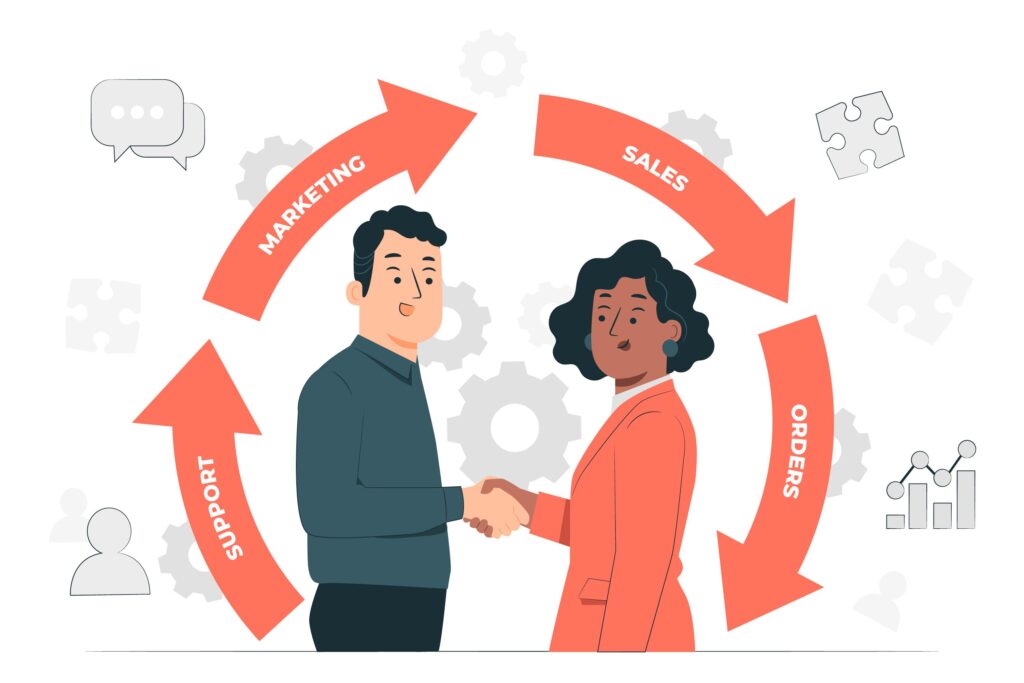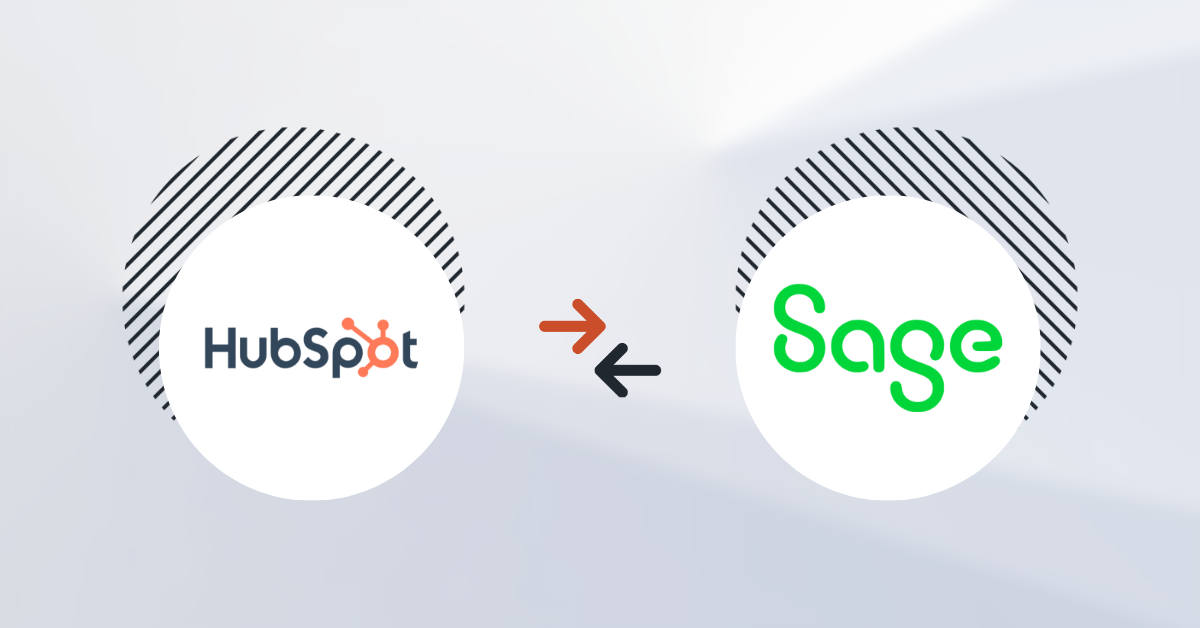As businesses grow, they tend to rely more and more on different tools to manage different projects, prospects, and deals in one central location. But this can lead to inefficiencies and errors when those tools don’t talk to each other. That’s why integrations between popular platforms like HubSpot and Sage can make such a big difference for many organizations.
The integration helps businesses to spend less time on manual tasks and focus more on growing their bottom line, making it an essential tool for any company looking to streamline its operations.Let’s take a closer look at how flawless HubSpot Sage Integration enhances your workflows.

HubSpot is a popular inbound marketing and sales platform. It’s designed to help businesses attract, engage, and delight customers by offering a suite of tools for content creation, SEO, lead generation, and more. HubSpot’s CRM (customer relationship management) tool is also a standout feature, allowing sales teams to manage their interactions with leads and customers in one place.
Read More about HubSpot integration
Unlocking the Power of Infor and HubSpot Integration
Sage is a cloud-based accounting software that’s used by small to medium-sized businesses all over the world. It provides a comprehensive suite of tools for invoicing, expense management, and financial reporting, among other things. With Sage, businesses can easily manage their finances, and stay on top of their cash flow.
Read more about Sage integration
Top Ways Sage ERP Integration Amps Up Your Business Data Quality & Business Performance
Contents
Common HubSpot Sage (ERP & CRM) Integration Scenarios
Lead Management: Automatically transfer leads from HubSpot to Sage CRM, ensuring that sales teams have access to the latest information and can quickly follow up with leads.
Contact Management: Keep your customer data up-to-date by synchronizing contact information between HubSpot and Sage CRM.
Opportunity Management: Automatically update opportunities in Sage CRM as they progress through the sales pipeline in HubSpot.
Account Management: Keep account information consistent by syncing account data between HubSpot and Sage CRM.
Order Management: Automatically transfer order information from eCommerce platforms to Sage CRM, ensuring that sales teams have access to the latest information on customer orders.
Invoicing: Automatically create sales invoice in Sage CRM based on information from HubSpot, saving time and improving accuracy.
Reporting: Gain a comprehensive view of your sales and customer interactions by combining data from HubSpot and Sage CRM in reports.
Recommended Reading: HubSpot – P21 Integration: A No-Nonsense Guide
Top Ways HubSpot Sage Integration Helps Your Business
Here’s a list of benefits
Streamlined Workflows: Integration automates data transfer between HubSpot and Sage, reducing manual entry of spreadsheets and the risk of errors.
Real-Time Two-way Data Sync: When ERP and CRM are integrated, data is automatically updated in both systems, eliminating the need for manual data entry. This leads to improved data accuracy, reducing the chances of errors and duplications.All customer and financial data is synced in real-time, providing a comprehensive view of each person.
Better Collaboration: Integrating these platforms gives sales, marketing, and finance teams access to the same data, improving cross-functional collaboration.
Seamless Lead Management: HubSpot is an excellent platform for lead management, and when integrated with Sage, you can get a complete view of your customer data and financial information. This integration helps you manage your leads effectively and increase your chances of closing a sale.
Enhanced Customer Experience: Integration of ERP and CRM allows businesses to have a 360-degree view of their customers. This helps in understanding their needs, tracking their interactions, and providing them with better services.
Enhanced Decision Making: With a complete view of customer and financial data, businesses can make informed decisions about growth and scaling.
Increased Productivity: Automating data transfer between platforms saves time and streamlines processes, increasing overall productivity.
Access to Data Anytime, Anywhere: Cloud-based integration allows access to data from anywhere, on any device.
Cost-Effective: Integration eliminates the need for manual data entry, reducing labor costs and increasing productivity.
Real-Time Data: Data is updated in real-time, providing accurate and up-to-date information.
Also, explore the multitude of benefits that come with Adobe Commerce and HubSpot integration and Benefits of BigCommerce HubSpot Integration Sage 100 edi integrations amazon edi integrations
Relevant Reading: Sage Adobe Commerce Integration: Get Started Now

Examples of Data to Sync between Sage and HubSpot
Customer Information: Sync customer data such as names, addresses, phone numbers, and email addresses between the two platforms to ensure that customer information is up-to-date and consistent.
Invoices and Orders: Keep track of invoices and orders by syncing this data between the platforms to accurately reflect the sales and billing information in both systems.
Products and Services: Keep your product and service offerings in sync, so your customers have access to the latest information on what you offer.
Inventory Management: Monitor your inventory levels and ensure that your stock levels are accurate by synchronizing this information between Sage Intacct and HubSpot.
Sales Performance: Monitor your sales performance and track your sales metrics by syncing data between the two platforms.
Accounting and Financial Data: Keep your accounting and financial data accurate and up-to-date by syncing data between Sage Intacct and HubSpot.
Marketing Metrics: Measure the success of your marketing efforts by syncing marketing metrics such as lead generation, conversion rates, and customer acquisition costs between the two platforms.
Read relevant article here: Understanding HubSpot NetSuite Integration
Steps to Integrate HubSpot CRM & Sage ERP
Determine Your Integration Requirements: Before integrating HubSpot and Sage, it’s essential to understand the processes and data you want to connect. Analyze your business operations to determine which data fields you need to sync and the level of integration you require. This will help ensure that your integration is as efficient and effective as possible.
Choose an Integration Solution: Once you’ve identified your integration requirements, it’s time to select a solution that will meet those needs. There are various integration options available, such as third-party integrator tools, API integrations, or a custom solution built by a developer. Consider factors such as the cost, level of technical expertise required, and compatibility with your systems when choosing a solution.
Connect HubSpot and Sage: The next step is to connect HubSpot and Sage using the integration solution you have chosen. This process will typically involve setting up API keys and credentials, configuring the connection settings, and configuring the data mapping.
Map Your Data Fields: In this step, you’ll map the data fields in HubSpot and Sage to ensure that the right data is synced between the two systems. This will involve specifying the fields that should be synced and how they should be mapped. It’s essential to get this step right to ensure accurate data transfer.
Test and Verify Your Integration: Finally, it’s time to test and verify your integration to ensure it’s working as expected. Test different scenarios to check that the data is being synced correctly, and resolve any issues that arise. Once you are confident that your integration is working correctly, you can start using it in your day-to-day operations.
Read more about Sage: Comprehensive Guide On Sage ERP System In 7 Fast Facts
Considerations When Integrating HubSpot and Sage
Integrating HubSpot and Sage is a significant step in streamlining your business operations. However, before implementing the integration, it’s essential to consider a few key considerations to ensure that it’s successful.
Data Management: Data management is a critical consideration when integrating HubSpot and Sage. Ensure that the integration solution you choose can handle the volume and complexity of your data, and that it will sync accurately and reliably. Consider factors such as data mapping, data validation, and data reconciliation to ensure that your data is managed effectively.
Security and Privacy: Security and privacy are crucial when integrating HubSpot and Sage, as sensitive customer and financial information will be exchanged. Make sure that the integration solution you choose complies with the relevant privacy and security regulations, such as GDPR and PCI DSS. Consider factors such as data encryption, data access controls, and data backup and recovery.
Technical Support: Technical support is another crucial consideration when integrating HubSpot and Sage. Ensure that the integration solution you choose offers adequate technical support and that the vendor has a proven track record of providing reliable support. Consider factors such as the availability of a knowledge base, the responsiveness of the vendor’s support team, and the availability of customer support options, such as email, phone, or live chat.
HubSpot Sage Integration from DCKAP
DCKAP offers a comprehensive HubSpot Sage integration solution DCKAP Integrator that helps businesses seamlessly connect their HubSpot marketing and sales platform with their Sage accounting and financial management system. The integration enables businesses to sync data between the two platforms in real-time, automate workflows, and streamline operations.
DCKAP Integrator is a cloud-based integration platform offered by DCKAP, a technology solutions provider. It enables businesses to connect their disparate systems and automate workflows, allowing data to be exchanged between different applications in real-time.
With DCKAP Integrator, businesses can synchronize data between various systems such as eCommerce platforms, accounting software, marketing automation tools, and more. This helps to eliminate manual data entry, reduce the risk of errors, and streamline operations. The platform is user-friendly and customizable, allowing businesses to integrate their systems in a way that best suits their specific needs and processes.
Here’s how DCKAP streamlines HubSpot Sage Integration with zero limitations:
- Understanding of customer behavior, such as shopping habits and preferences, and their needs through the integration of HubSpot with your ecommerce platform and ERP solution using DCKAP Integrator.
- Ability to analyze the level of brand loyalty and affinity among customers.
- Data-driven insights into the rate of customer churn, allowing you to take proactive measures to retain customers.
- Accurate calculation of the lifetime value of each customer and the share of their total spending with your brand.
- Identification of potential upsell and cross-sell opportunities through analysis of customer data.
- Knowledge of customers’ preferred channels for making purchases and receiving support.
- Comprehensive analysis of customer support statistics, including response times and satisfaction ratings.
Read more about HubSpot CRM: Infor Integration Explained: Achieve Competitive Edge and Growth
Unleash the power of seamless HubSpot Sage integration, Powered by DCKAP Integrator
The HubSpot Sage Integration unlocks the power of seamless workflows to create a centralized list of information for small and large businesses of all sizes. This connector allows clients, users, marketing teams, and customer service teams to access important data points and resources in real-time. In a nutshell, by integrating with the HubSpot CRM, companies can streamline their sales process, automate sales invoicing, and access important business applications, all while saving valuable time.
DCKAP Integrator opens up a world of possibilities for businesses. From unlocking deeper customer insights to streamlining workflows, the benefits of various integrations including this are numerous. The result is a more efficient and effective operation, allowing you to better serve your customers and grow your business. No matter whether you run a small small business or large enterprise, take your business to the next level. Get in touch with our experts in DCKAP to learn more about how our integrator tool can help you achieve seamless integration.




